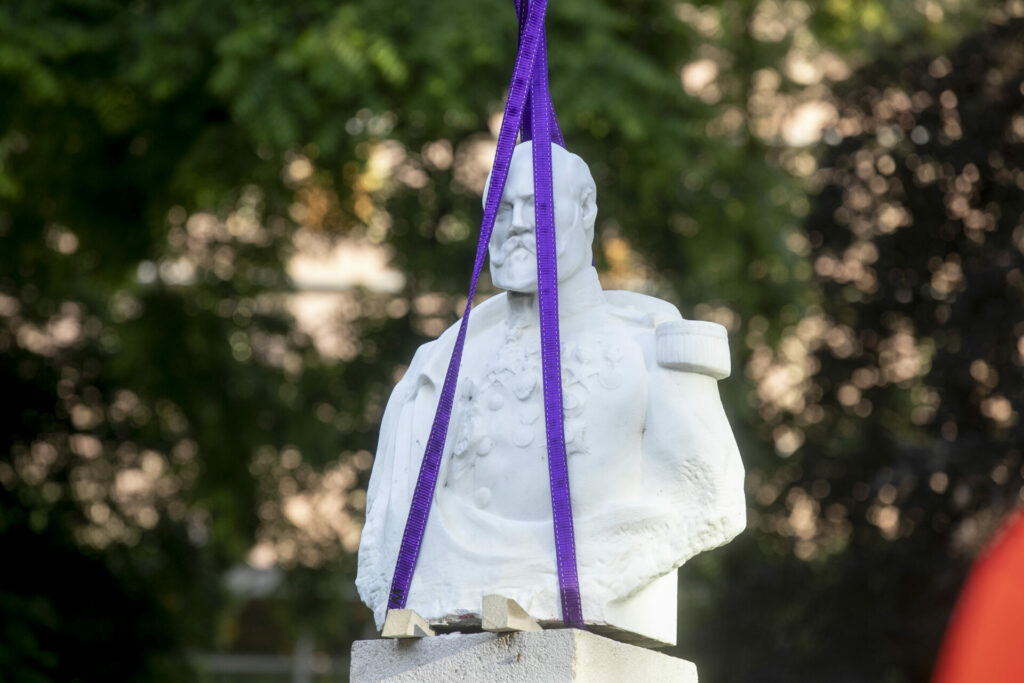The statue of Lieutenant General Emile Storms, one of Belgium’s early colonial elite, was removed on Thursday morning. However, in doing so, the municipal council of Ixelles committed an urban planning violation, resulting in an official report from urban.brussels, Bruzz reports.
As Storms conquered large parts of the Congo Free State on behalf of King Leopold II, not shunning the violence, the statue was repeatedly targeted with spray paint and vandalised by activists.
The statue was removed after pressure from the Mayor of Ixelles, Christos Doulkeridis, and anti-racist activists.
2020 application
The municipality submitted an application for permission to dismantle the bust of Lieutenant General Storms and the pedestal on Square de Meeûs as early as 2020, which required a complete historical analysis of the square to determine its original composition.
As the original bust was stolen by the Germans in 1943 and replaced by a marble copy, it doesn’t belong to the original protected piece. The Royal Museums of Fine Arts of Belgium and the Museum of Ixelles have offered to expose the statue within its historical context.
The removal of the bust
On Congo’s Independence Day, 30 June, the Ixelles municipal council removed the bust of General Emile Storms from its pedestal in Square de Meeûs.
Mayor Christ Doulkeridis aimed to have the statue removed in 2020, on the 60th anniversary of Congo’s independence, but the Brussels State Secretary for Heritage, Pascal Smet, asked him to wait for the conclusions of the decolonisation working group and the government’s subsequent action plan.
That working group formulated its recommendations on how colonial heritage should be approached in February 2022. The Brussels government would then take a position on these recommendations before the regional agency Urban.brussels would develop an action plan in consultation with other regional agencies and administrations.
However, Doulkeridis did not want to wait for that last stage. “The conclusions are now there and they are in line with what I think about this issue: there is no reason to leave this statue in public space,” he told Bruzz in May this year. Yesterday, on June 30, 2022, he put his money where his mouth is and had the bust removed.
Urban planning violation
“That didn't quite go according to the book,” says Valérie Mertens, spokesperson for Pascal Smet. Today, the municipality receives an official report from the ISA (the sanctioning body within Urban.brussels).
“The municipality of Ixelles has committed an offense with the removal of the Emile Storms monument,” confirms Thierry Wauters, director of Cultural Heritage at Urban.Brussels.
Related News
- Colonial statue of Émile Storms removed from Ixelles
- Charleroi provides context for 'glory of colonial veterans' statue
- Belgium considers granting mixed-race children full access to colonial archives
“The removal of a protected statue requires an urban planning application, which the municipality has failed to apply even though it is well aware of the procedure. The KCML normally gives advice, and a public inquiry must also be held, because it is a protected square,” explains Wauters.
Wauters expects a decision from the government on the decolonisation of public space by September. “Ixelles acted too quickly,” he said. “By stubbornly removing the statue, the public debate about the decolonisation of public space is crippled.”
“We are now looking at how to regularise the violation,” said Pascal Smet's spokesperson. The intention is that the bust will be moved to a museum.
'All conditions were met'
However, Doulkeridis’ cabinet said it acted acted according to the regulations. “Until now we still haven’t received a report from Urban.brussels,” says Aline Lacroix, spokesperson for Mayor Christos Doulkeridis.
“We submitted an urban planning application in 2020, in which three conditions were formulated for the removal of the statue. All conditions have been met," the spokesperson said.
A historical study of the park had to be made, then the municipality had to wait for the advice of the decolonisation working group, and finally, the statue had to be given a place in a museum.
“There are now two avenues for this. Both the Ixelles Museum and the Royal Museums of Art and History have indicated that they want to place the image in its context.” Lacroix said.

